Gas sensing element and its manufacturing method
a technology of gas sensing element and manufacturing method, which is applied in the direction of measurement devices, material electrochemical variables, instruments, etc., can solve the problems of inability to accurately control the processing of shot blast, inability to open small holes, and difficulty in forming through holes with a diameter of 100 m or less, so as to achieve accurate control of irradiation position, laser irradiation processing is easy to realize, and the effect of high energy density
- Summary
- Abstract
- Description
- Claims
- Application Information
AI Technical Summary
Benefits of technology
Problems solved by technology
Method used
Image
Examples
first embodiment
[0062] A method for manufacturing a gas sensing element in accordance with a first embodiment of the present invention will be explained with reference to FIGS. 1 to 3. The gas sensing element of the first embodiment is a multilayered gas sensing element including a solid electrolytic substrate. A measured gas side electrode and a reference electrode are provided on surfaces of this solid electrolytic substrate. The measured gas side electrode is provided in a measured gas chamber. An introducing hole forming layer has an introducing hole for introducing a measured gas from an ambient atmosphere into the measured gas chamber and also providing a diffusion resistance to the measured gas introduced into the measured gas chamber. In manufacturing this gas sensing element, laser irradiation is applied onto the introducing hole forming layer to form the introducing hole.
[0063] More specifically, the gas sensing element of this embodiment is a limiting-current type element incorporated i...
second embodiment
[0072] This embodiment is, as shown in FIG. 4, characterized in that the convex lens 32 and a concave lens 33 are used to irradiate the laser onto the introducing hole forming layer 15. More specifically, both the convex lens 32 and the concave lens 33 are disposed between the laser generator 3 and the sintered body 39, so that the focal point of the convex lens 32 is positioned on the surface 330 of the concave lens 33. The laser 30 emitted from the laser generator 3 converges at the convex lens 32 and forms a focus on or in the vicinity of the surface of the concave lens 33. The laser, after having entered in the concave lens 33, becomes a parallel beam while keeping a beam diameter and then exits out of the concave lens 33. Then, the laser arrives at the irradiation position 391 on the surface 151 of the introducing hole forming layer 15. Accordingly, this embodiment adjusts both the convex lens 32 and the concave lens 33 to obtain a parallel beam having an arbitrary diameter whi...
third embodiment
[0074] This embodiment is characterized in that, in manufacturing a gas sensing element having an introducing hole similar to that of the first embodiment, the laser irradiation processing is controlled by optically observing the irradiation position 391 of the laser 30 irradiated onto the introducing hole forming layer 15.
[0075] Hereinafter, this embodiment will be explained in more detail. As shown in FIG. 5, an optical observing apparatus 4 is prepared. More specifically, the optical observing apparatus 4 includes an optical fiber 41, a visible-to-ultraviolet light range spectroscope 42, a photoelectric converter 43, and an A / D converter recorder-controller 44. The optical fiber 41 transmits a light emitted from the irradiation position 391 to the visible-to-ultraviolet light range spectroscope 42. The photoelectric converter 43 is placed behind the visible-to-ultraviolet light range spectroscope 42. The A / D converter recorder-controller 44 is placed behind the photoelectric con...
PUM
| Property | Measurement | Unit |
|---|---|---|
| diameter | aaaaa | aaaaa |
| wavelength | aaaaa | aaaaa |
| pore diameter | aaaaa | aaaaa |
Abstract
Description
Claims
Application Information
 Login to View More
Login to View More - R&D
- Intellectual Property
- Life Sciences
- Materials
- Tech Scout
- Unparalleled Data Quality
- Higher Quality Content
- 60% Fewer Hallucinations
Browse by: Latest US Patents, China's latest patents, Technical Efficacy Thesaurus, Application Domain, Technology Topic, Popular Technical Reports.
© 2025 PatSnap. All rights reserved.Legal|Privacy policy|Modern Slavery Act Transparency Statement|Sitemap|About US| Contact US: help@patsnap.com



